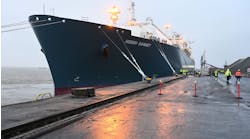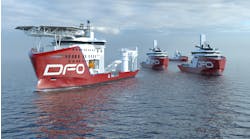Offshore Staff
HOUSTON -- SBM and FMC both shared an opportunistic outlook for the use of disconnectable turret moored FPSOs in the deepwater Gulf of Mexico. The companies explained at DOT on Tuesday.
Yong Lou with SBM IMODCO Inc. argued that the number one benefit of using this type of floating production facility in the Gulf is to avoid hurricanes. The vessel could be disconnected from its turret in as little as 15 minutes, said Lou. A typical planned disconnection takes around 6 hours.
The disconnectable FPSO solution is proven in regions with similar harsh weather conditions, such as off northwest Australia and in the South China Sea, he said.
The turret is the key component for the disconnection mechanism, Lou explained. He pointed to two types that would be ideal for this solution in the Gulf; buoy turret mooring and riser turret mooring. Polyester rope would be used with the system.
Lou concluded with four advantages of using a disconnectable FPSO vs. a DP solution: lower CAPEX, reduced operating cost, higher reliability, and no need for riser QC/DC.
Arun Duggal with FMC Technologies Floating Systems Inc. shared a similar opinion about the use of disconnectable FPSOs in the Gulf of Mexico.
Disconnectable turret technology with FPSOs has been used successfully in the areas pointed out by Lou, since the 1980's, said Duggal. The FPSO operating on the Santos-operated Mutineer/Exeter field off northwest Australia has been disconnected five times this year to avoid cyclones.
One of the major challenges in using this technology in the Gulf of Mexico is that it will be required for deepwater, explains Duggal. This solution is typically used in water depths of less than 200 m (656 ft), he said.
However, we can learn from the BHP-operated Stybarrow FPSO, which is planned for installation in 800 m (2,625 ft) of water off northwest Australia, he added. Installation is scheduled to be under way by the end of this year.


